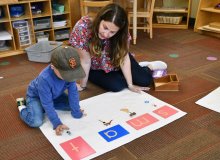The Montessori Three-Period Lesson

A Simple and Powerful Approach to Learning
In Montessori classrooms, the three-period lesson is a time-tested method used to introduce new concepts, strengthen understanding, and expand vocabulary. This interactive approach guides children toward mastery while keeping lessons engaging and developmentally appropriate.
How It Works
The three-period lesson is structured in a way that gradually builds confidence and comprehension:
- First Period: Introduction – The teacher presents an object or concept by naming it clearly. ("This is the letter A.")
- Second Period: Recognition & Association – The child is asked to identify the object in different ways. ("Can you point to the letter A? Put the letter A in your hand.") Rearranging, covering, or hiding objects turns this step into a fun, interactive game.
- Third Period: Recall – The child demonstrates understanding by naming the object independently. ("Can you tell me what letter this is?") If the child struggles, the teacher gently reintroduces the name and revisits the lesson later.
Why It’s So Effective
This method is more than just a teaching technique—it’s a form of scaffolding, a process where support is gradually removed as a child gains confidence. Montessori teachers carefully observe students to provide just the right level of challenge, fostering both independence and a love of learning.
By using the three-period lesson, Montessori educators help children build a strong foundation of knowledge while encouraging curiosity, exploration, and growth—hallmarks of an Inly education!









